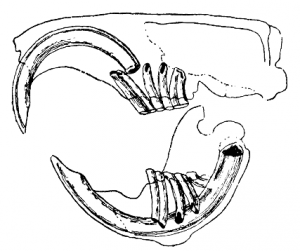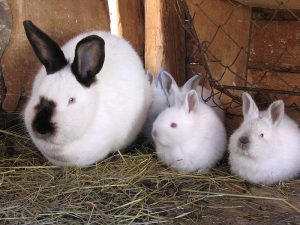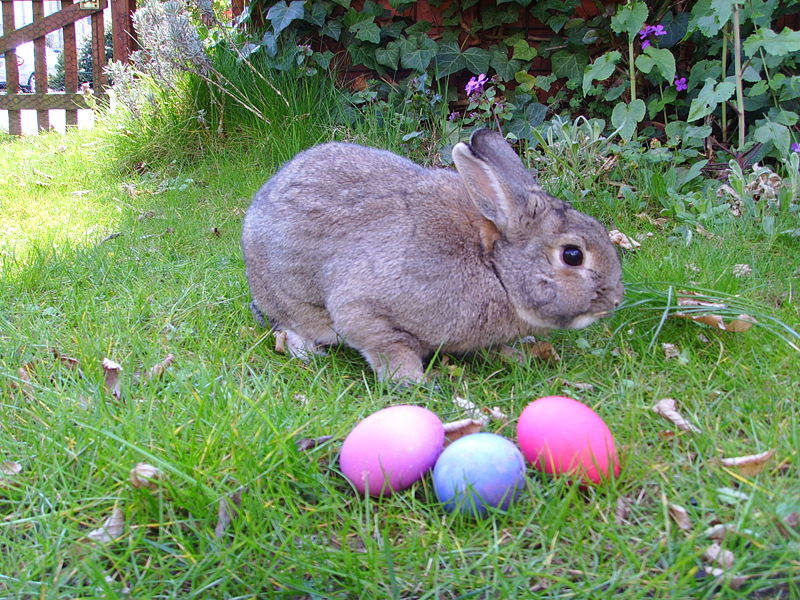Distinguishing the Differences Between Rabbits and Rodents: Why Rabbits are Not Rodents
Photo: Wiki Commons
It's All In The Teeth...Well, Actually There's More.....
The iconic image of spring is that of rabbits and bunnies, and for those with a chocolate penchant the Cadbury bunny and his chocolate eggs. In honor of Spring I decided it's time for a post on the confusion I commonly find, when leading programs, about why rabbits are not rodents. First, there's a wide range of rodents living in the world, in fact it's the largest class of mammals. They're everywhere and on nearly every continent. Rodents can range in size from .25 oz (the African pygmy mouse) to the capybara which can weigh from 150-200 lbs!

The order Rodentia, from which rodents get their name, derives from the Latin meaning "to gnaw or chew." This is what makes them unique, their teeth. Dentition is a commonly used feature for biologists to sort animals into families and orders. Rodents are specialized gnawers. They all have one set of upper and lower incisors (front teeth) and varying numbers of molars and per-molars (flat teeth in the back of the mouth) with a gap in-between called the diastema. Rodents lack canine teeth. The outer surface of rodent incisors is covered with enamel which ranges from orange to orangish-yellow in coloring (If you find a skull with these colors on the incisors it's always a rodent). It's thought that this coloring is due to strengthening by the addition of iron and minerals. The front of the tooth is very hard compared to the back of the tooth which is covered in dentin, a soft pulpy material. Unlike humans, whose teeth stop growing when they reach a certain stage, a rodent's incisors erupt/grow continually. This is called indeterminate growth. The tooth can continually grow because the base of a rodent's incisors is rootless and open so the tooth keeps growing. Human teeth have roots and are mostly closed off because the teeth do not need to grow anymore.

Because their incisors grow all the time rodent teeth must be worn down by chewing. Wear occurs in the gnawing process when the upper incisor closes down over the lower incisor. During this gnawing the soft dentin in the back of the tooth is worn down by the scissoring action, leaving the harder enamel to sharpen and become a chisel like tool. Plant matter is snipped off and then passed through the diastema (gap) to the back teeth to be ground up (note: the back teeth are determinate, they stop growing). The ability to chew or gnaw is handy. Rodents can chew through hard wood or fibrous plant matter, gnaw tough roots or tubers, protect themselves, and even eat a variety of foods such as hard nuts, fruits, and insects.
If a rodent's incisors are not worn down there is the possibility of big trouble. The incisors could grow into their lower jaw and close the animal's mouth in a painful way. I have found the skulls of old rodents with the teeth growing through the lower jaw or one incisor so long they couldn't open one side of their mouth! This is why it's important for pet owners to give their pet gerbils, hamsters, and rats something to chew on. If rodents can't gnaw down their incisors then it could kill them or mean an expensive trip to the vet where he or she will use clippers to cut their teeth, ouch!
Now wait a minute, you're thinking, "Don't rabbits look like rodents? They also eat plants, chew things, and have long pointy teeth right? So why aren't they rodents?" Rabbits are in the order Lagomorpha not Rodentia. At one time they were lumped together, but now they are separate for a number of reasons.

1. Digestive Differences
Yes, rabbits and rodents eat plant matter, but rabbits are obligate herbivores while rodents may eat grains, seeds, nuts, tubers, roots, or plant matter. Because rabbits are obligate herbivores their digestive system is a bit different. They break down their food like hooved mammals. Inside the guts of rabbits, cows, and horses you will find a cecum (which is Latin for "blind pouch"...I used to tell my Zoology students "Cecum and ye shall find em'). It is literally a pouch found at the head of the large intestine that has a bunch of beneficial bacteria in it for breaking down and fermenting the difficult to eat cellulose of plants. Now here's where the gross stuff come in. When a rabbit eats vegetation it maximizes digestion by eating it twice...wait for it.....yes, it eats its own poop pellets. This is how it works; a rabbit eats plant material, which passes through its digestive tract, this is pooped out as a soft black type of pellet called a caecotroph which is then eaten, re-chewed and digested, and pooped out as the familiar hard round pellets we all know and recognize. You may have heard of this process, it's called coprophagy. Dog owners may be familiar with this hard-to-break habit in their family Fido. Poop eating rabbits kind of skews the whole "Easter Bunny" cuteness but it serves a good purpose. They can maximize the amount of nutrients they absorb by re-processing the food a second time. Notably, a few rodents also have a cecum, like guinea pigs and chinchillas, which also eat their own poop but by far it's the exception in rodents.
2. Differences in Teeth
The teeth of rabbits are similar and yet different from rodents. Both rodents and rabbits have a indeterminate growth in their incisors. They also have hard enamel on the external surface of the incisors and a soft dentin behind; but the front of rabbit incisors is white and not orange like rodents. Rabbits also have two sets of top incisors, not one. There is a tiny set of peg like teeth behind these top incisors which is about 1/4 the size of the incisors. This is thought to allow rabbits to cut through vegetation more easily, though it can cause some dental problems when there is malocclusion.
3. Differences in Male Reproductive Bits (be prepared for some biology here folks...those with small children stop reading aloud now)
Male rabbits and rodents don't have one scrotal sac, they have two discrete sacs which can be contracted into their body cavity when necessary. Most mammals have a baculum, or penis bone, that provides stiffness for the male's penis and allows them to mate for a longer period of time. Rodents have baculum bones but rabbits and Lagomorphs do not. Rabbits are actually in good company because humans, horses, cetaceans (whales and dolphins), and marsupials don't have baculum bones either. The baculum is an evolutionary adaptation allowing for faster and possibly longer matings. The process of hydraulics for those without a baculum is much slower than inserting a bone structure into the genitalia and causing instant erection. Rapid erection also decreases threat from predators because the animal spends less time in conspicuous or exposed mating positions.

Although biology sometimes seems to take away the magic of the cute furry woodland creatures, it's an important part of understanding how and why nature works like it does. Now that you know the differences between rabbits and rodents you too can amaze your friends with fun Spring facts. I still love rabbits and they hold a special place in my heart (despite their poop eating habits), especially around Easter.


